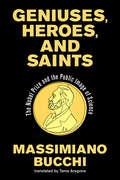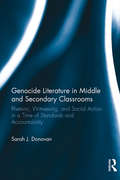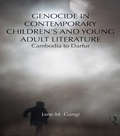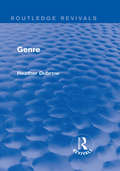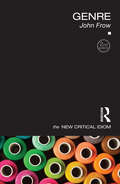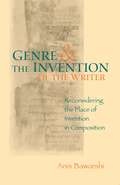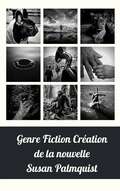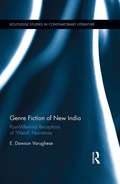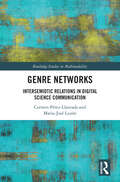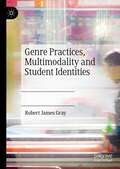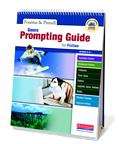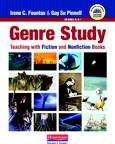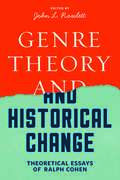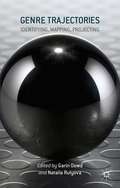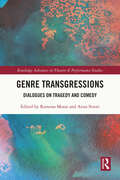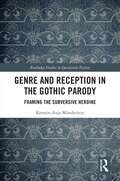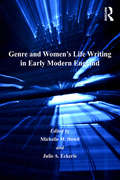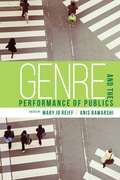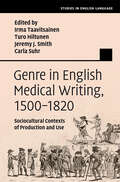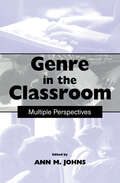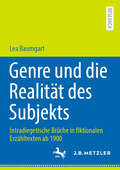- Table View
- List View
Geniuses, Heroes, and Saints: The Nobel Prize and the Public Image of Science
by Massimiano BucchiA rich account of the world&’s leading science prize told through the lives it has changed, the controversies it has generated, and the impact it has made on the public.In a world where the work of science largely remains inscrutable to the general public, the Nobel Prize confers a degree of intelligibility like no other honor. Our best-known and most prestigious award for individual scientific achievement, the Nobel attaches a brilliant face to a story of profound discovery, making moving headlines. In Geniuses, Heroes, and Saints, Massimiano Bucchi tells an equally compelling story of the Nobel&’s transformation of science into an epic pursuit legible both to the field and to the public, bound up with the currents of historical change.Three main narratives characterize the Nobel. The scientist as genius, portrayed as a creative visionary, an exceptional intellect reflecting a solitary and romantic ideal of great communicative impact. The scientist as national hero acts as a surrogate of competition among nations in a peaceful, rational contest. The scientist as saint shines with moral exceptionality, a figure worthy of celebration and worship, known for virtues such as modesty, humility, and total dedication, body and soul, to the scientific enterprise. Whether the recipient was Albert Einstein or a countryside doctor toiling for years in obscurity, whether the prize was worthily given or awarded to work later disproved, or whether we even remember the honorees today, the Nobel defined the image of science in the twentieth century, Bucchi shows, an image that still lives in all sorts of fascinating ways today.
Genocide Literature in Middle and Secondary Classrooms: Rhetoric, Witnessing, and Social Action in a Time of Standards and Accountability
by Sarah DonovanAt the heart of this inquiry into the ethical implications of education reform on reading practices in middle and secondary classrooms, the central question is what is lost, hidden, or marginalized in the name of progress? Drawing on her own experiences as an English teacher during the No Child Left Behind era, the author examines school cultures focused on meeting standards and measurable outcomes. She shows how genocide literature illuminates the ethics of reading and helps teachers and students rethink how literature should be taught in this modern, globalized era and the purposes of education more broadly.
Genocide in Contemporary Children's and Young Adult Literature: Cambodia to Darfur (Children's Literature and Culture)
by Jane GangiThis book studies children’s and young adult literature of genocide since 1945, considering issues of representation and using postcolonial theory to provide both literary analysis and implications for educating the young. Many of the authors visited accurately and authentically portray the genocide about which they write; others perpetuate stereotypes or otherwise distort, demean, or oversimplify. In this focus on young people’s literature of specific genocides, Gangi profiles and critiques works on the Cambodian genocide (1975-1979); the Iraqi Kurds (1988); the Maya of Guatemala (1981-1983); Bosnia, Kosovo, and Srebrenica (1990s); Rwanda (1994); and Darfur (2003-present). In addition to critical analysis, each chapter also provides historical background based on the work of prominent genocide scholars. To conduct research for the book, Gangi traveled to Bosnia, engaged in conversation with young people from Rwanda, and spoke with scholars who had traveled to or lived in Guatemala and Cambodia. This book analyses the ways contemporary children, typically ages ten and up, are engaged in the study of genocide, and addresses the ways in which child survivors who have witnessed genocide are helped by literature that mirrors their experiences.
Genre (Routledge Revivals #Vol. 42)
by Heather DubrowThis study, first published in 1982, explores and demonstrates the ways in which an awareness of literary genre can illuminate works as diverse as Milton’s ‘Lycidas’ and Berryman’s Sonnets. The first book to offer a historical survey of genre theory, it traces the history from the Greek rhetoricians to such contemporary figures as Frye and Todorov. Particular emphasis is placed on the ways in which comments on genre reflect underlying aesthetic attitudes.
Genre (The New Critical Idiom)
by John FrowThis second edition of John Frow’s Genre offers a comprehensive and accessible introduction to the area. Genre is a key means by which we categorize the many forms of literature and culture, but it is also much more than that: in talk and writing, in music and images, in film and television, genres actively generate and shape our knowledge of the world. Understanding genre as a dynamic process rather than a set of stable rules, this book explores: the relation of simple to complex genres the history of literary genre in theory the generic organisation of implied meanings the structuring of interpretation by genre the uses of genre in teaching. John Frow’s lucid exploration of this fascinating concept has become essential reading for students of literary and cultural studies, and the second edition expands on the original to take account of recent debates in genre theory and the emergence of digital genres.
Genre And The Invention Of The Writer: Reconsidering the Place of Invention in Composition
by Anis BawarshiIn a focused and compelling discussion, Anis Bawarshi looks to genre theory for what it can contribute to a refined understanding of invention. In describing what he calls "the genre function," he explores what is at stake for the study and teaching of writing to imagine invention as a way that writers locate themselves, via genres, within various positions and activities. He argues, in fact, that invention is a process in which writers are acted upon by genres as much as they act themselves. Such an approach naturally requires the composition scholar to re-place invention from the writer to the sites of action, the genres, in which the writer participates. This move calls for a thoroughly rhetorical view of invention, roughly in the tradition of Richard Young, Janice Lauer, and those who have followed them. Instead of mastering notions of "good" writing, Bawarshi feels that students gain more from learning how to adapt socially and rhetorically as they move from one "genred" site of action to the next.
Genre Fiction Création de la nouvelle
by Susan PalmquistConcevoir l'histoire courte Apprendre à Évitez les pièges courants de la rédaction de nouvelles Les écrivains débutants commettent souvent des erreurs courantes qui, avec un peu de savoir-faire, peuvent être corrigées ou évitées. Créez l'intrigue parfaite pour votre nouvelle Dans Crafting the Short Story, vous apprendrez la principale différence entre l'intrigue de la nouvelle et celle du roman et comment cela peut augmenter vos chances de publier votre histoire. Créez un personnage que vos lecteurs adoreront Faire en sorte que vos lecteurs apprécient la lecture de votre personnage et de son histoire est essentiel et vous apprendrez comment faire spécifiquement pour cette forme plus courte. Recherchez et trouvez le marché le mieux adapté à votre histoire Une fois que vous avez créé l'histoire parfaite, vous devez lui trouver un foyer et il y a deux chapitres consacrés à la recherche du marché et aux endroits où chercher les marchés des nouvelles.
Genre Fiction of New India: Post-millennial receptions of "weird" narratives (Routledge Studies in Contemporary Literature)
by E. Dawson VarugheseThis book investigates fiction in English, written within, and published from India since 2000 in the genre of mythology-inspired fiction in doing so it introduces the term ‘Bharati Fantasy’. This volume is anchored in notions of the ‘weird’ and thus some time is spent understanding this term linguistically, historically (‘wyrd’) as well as philosophically and most significantly socio-culturally because ‘reception’ is a key theme to this book’s thesis. The book studies the interface of science, Hinduism and itihasa (a term often translated as ‘history’) within mythology-inspired fiction in English from India and these are specifically examined through the lens of two overarching interests: reader reception and the genre of weird fiction. The book considers Indian and non-Indian receptions to the body of mythology-inspired fiction, highlighting how English fiction from India has moved away from being identified as the traditional Indian postcolonial text. Furthermore, the book reveals broader findings in relation to identity and Indianness and India’s post-millennial society’s interest in portraying and projecting ideas of India through its ancient cultures, epic narratives and cultural (Hindu) figures.
Genre Knowledge in Disciplinary Communication: Cognition/culture/power
by Carol Berkenkotter Thomas N. HuckinAlthough genre studies abound in literary criticism, researchers and scholars interested in the social contexts of literacy have recently become interested in the dynamic, rhetorical dimensions of speech genres. Within this burgeoning scholarly community, the authors are among the first researchers working within social science traditions to study genre from the perspective of the implicit knowledge of language users. Thus, this is the first sociocognitive study of genre using case-study, naturalistic research methods combined with the techniques of rhetorical and discourse analysis. The term "genre knowledge" refers to an individual's repertoire of situationally appropriate responses to recurrent situations -- from immediate encounters to distanced communication through the medium of print, and more recently, the electronic media. One way to study the textual character of disciplinary knowledge is to examine both the situated actions of writers, and the communicative systems in which disciplinary actors participate. These two perspectives are presented in this book. The authors' studies of disciplinary communication examine operations of systems as diverse as peer review in scientific publications and language in a first grade science classroom. The methods used include case study and ethnographic techniques, rhetorical and discourse analysis of changing features within large corpora and in the texts of individual writers. Through the use of these techniques, the authors engaged in both micro-level and macro-level analyses and developed a perspective which reflects both foci. From this perspective they propose that what micro-level studies of actors' situated actions frequently depict as individual processes, can also be interpreted -- from the macro-level -- as communicative acts within a discursive network or system. The research methods and the theoretical framework presented are designed to raise provocative questions for scholars, researchers, and teachers in a number of fields: linguists who teach and conduct research in ESP and LSP and are interested in methods for studying professional communication; scholars in the fields of communication, rhetoric, and sociology of science with an interest in the textual dynamics of scientific and scholarly communities; educational researchers interested in cognition in context; and composition scholars interested in writing in the disciplines.
Genre Networks (Routledge Studies in Multimodality)
by Carmen Pérez-Llantada María-José LuzónThis innovative book employs genre as a fruitful lens for exploring the complexity of science communication online and the new genre assemblages formed at the interface of multiple genres in digital environments. Pérez-Llantada and Luzón argue for a conceptualization of Science 2.0 that views digital genres in conjunction with other genres, accounting for the ways in which diverse Internet users choose different points of entry for accessing information on science of varied depth, views, and perspectives. Taking Swales’s conceptualization of forms of genre collectivity as its point of departure, the book puts forward this new understanding of multisemiotic genre assemblages in digital science communication, considering dimensions of hypertextuality, intertextuality, and multimodality in the interdependent relations between genres. The volume draws on a range of case studies each with a distinct genre assemblage and social agenda, exploring such areas as high stakes science, open peer review, science reproducibility, citizen science, and social media networking. Offering new directions for future research on genre studies and digital science communication, Genre Networks: Intersemiotic Relations in Digital Science Communication will be of interest to scholars in these fields, as well as those working in multimodality, language and communication, and languages for academic purposes.
Genre Practices, Multimodality and Student Identities
by Robert James GrayThis book offers a novel framework for describing and understanding student identity via the central concept of "genre practices", developed through an empirical focus on multimodality within the genre of English as a medium of instruction (EMI) undergraduate presentations. The author draws on interviews with undergraduate psychology students and recordings of their presentations to argue that by engaging in the multimodal practices of classroom presentations, presenters (re)produce both the genre and their identities as students. The resulting theory of student identity is widely applicable to tertiary settings, and the methodology described is applicable to the study of practices and identity in a range of other classroom genres. The book will therefore be of interest not only to researchers in EMI and TESOL settings, but also any tertiary-level educational practitioners whose courses include presentations.
Genre Prompting Guide For Fiction
by Gay Su Pinnell Irene C. FountasThe prompts in these ready-reference flip charts are designed to help teachers guide students' inquiry toward explicit understandings of the characteristics of genres. Each prompting guide contains precise language for teaching readers how to focus their thinking and understanding of genres through inquiry. In the Genre Study Prompting Guide for Fiction, Fountas and Pinnell have organized fiction prompts by genre as well as by literary elements and structure. Help you and your students lay the groundwork for a lifetime of literacy exploration and an understanding of the following genres: Contemporary Realistic Fiction Historical Fiction Traditional Literature Folktales Fairy Tales Fables Legends Epics Ballads Myths Modern Fantasy Animal Fantasy Low Fantasy High Fantasy Science Fiction
Genre Quick Guide K-8+
by Gay Su Pinnell Irene C. FountasThis spiral-bound companion to Genre Study: Teaching with Fiction and Nonfiction Books is designed to help you actively engage students in the exploration of texts so that they can notice and name genre characteristics and construct working definitions that guide their thinking as readers and writers. This handy reference guide contains a master genre chart outlining the definitions, key characteristics (noticings), and a list of mentor texts by genre. In this resource, Irene Fountas and Gay Su Pinnell help you and your students lay the groundwork for a lifetime of literacy exploration and an understanding of the following genres: Fiction Genres Realistic Fiction Historical Fiction Fantasy Traditional Literature folktales fairy tales fables legends epics ballads myths Modern Fantasy animal fantasy low fantasy high fantasy Science Fiction Nonfiction Genres Nonfiction Narrative Nonfiction Biography Autobiography Memoir Expository Nonfiction Persuasive Procedural Hybrid Forms of Poetry
Genre Study: Teaching With Fiction and Nonfiction Books
by Gay Su Pinnell Irene C. FountasGenre Study: Teaching with Fiction and Nonfiction Books is the foundational text of the Genre Study Suite. In exploring Genre Study, Fountas & Pinnell advocate teaching and learning in which students are actively engaged in developing genre understandings and applying their thinking to any genre. It is through using genre understandings that your students think, talk, and read texts with deeper understanding, and write effectively. Genre Study is a professional resource that teachers can use with students to embark on an exciting exploration into the study of genre. View Overview Webinar The Genre Study Suite Bundle is a comprehensive suite of resources that focuses on genre study through inquiry-based learning with an emphasis on reading comprehension and the craft of writing. An inquiry approach engages students in exploring texts so that they can notice and name the characteristics of each genre and construct a working definition that guides their thinking of reading and writing. This suite provides the tools needed to help you and your students lay the groundwork for a lifetime of literacy exploration. The bundle includes: Genre Study: Teaching with Fiction and Nonfiction Books Genre Study Quick Guide a companion to Genre Study: Teaching with Fiction and Nonfiction Books This spiral-bound companion to Genre Study: Teaching with Fiction and Nonfiction Books is designed to help you actively engage students in the exploration of texts so that they can notice and name genre characteristics, and construct working definitions that guide their thinking as readers and writers. This handy reference guide contains a master genre chart outlining the definition, key characteristics, and a list of mentor texts by genre. Genre Prompting Guide for Fiction and Genre Prompting Guide for Nonfiction, Poetry, and Test Taking are comprehensive tools that you can use to explore genres with your students during interactive read-aloud, Reader's workshop, Writer's workshop, guided reading lessons, shared reading, and intervention lessons. The prompts in these ready reference flip charts are designed to help teachers guide students' inquiry toward explicit understandings of the characteristics of genres. In the Genre Prompting Guides, Fountas & Pinnell have organized prompts by genre, and also literary elements and structure. Fiction Genres Realistic Fiction Historical Fiction Traditional Literature (including folktales, fairy tales, fables, epics, legends, ballads, and myths) Modern Fantasy (including simple animal fantasy, low fantasy, high fantasy, and science fiction) Nonfiction Genres Narrative Nonfiction Biography Autobiography Memoir Expository Nonfiction Procedural Texts Persuasive tests Forms of Poetry Lyrical poetry Narrative poetry Free Verse Haiku Limericks Concrete poems Test Taking Multiple Choice Questions Short Answer Questions Extended Response Questions
Genre Theory and Historical Change: Theoretical Essays of Ralph Cohen
by Ralph CohenRalph Cohen was highly regarded as the visionary founding editor of New Literary History, but his own theoretical essays appeared in such a scattering of publications that their conceptual originality, underlying coherence, and range of application have not been readily apparent. This new selection of twenty essays, many published here for the first time, offers a synthesis of Cohen’s vital work. In these pages Cohen introduces change and continuity as essential modes of discourse in the study of literary behavior, an approach that can produce reliable narratives of literary, artistic, and cultural change. Here Cohen conceptualizes and develops a compelling, innovative theory of genre that promotes a systematic study of historical change, offering rewarding insights for twenty-first-century scholars.
Genre Trajectories: Identifying, Mapping, Projecting
by Garin Dowd Natalia RulyovaThis book provides a fresh interdisciplinary perspective on genre and identifies developments in genre studies in the early 21st century. Genre approaches are applied to examine a fascinating range of texts including ancient Greek poems, Holocaust visual and literary texts, contemporary Hollywood films, selfies, melodrama, and classroom practices.
Genre Transgressions: Dialogues on Tragedy and Comedy (ISSN)
by Ramona Mosse Anna StreetThis collection gathers a set of provocative essays that sketch innovative and interdisciplinary approaches to Genre Theory in the 21st century. Focusing on the interaction between tragedy and comedy, both renowned and emerging scholarly and creative voices from philosophy, theater, literature, and cultural studies come together to engage in dialogues that reconfigure genre as social, communal, and affective.In revisiting the challenges to aesthetic categorization over the course of the 20th century, this volume proposes a shift away from the prescriptive and hierarchical reading of genre to its crucial function in shaping thought and enabling shared experience and communication. In doing so, the various essays acknowledge the diverse contexts within which genre needs to be thought afresh: media studies, rhetoric, politics, performance, and philosophy.
Genre Transgressions: Dialogues on Tragedy and Comedy (Routledge Advances in Theatre & Performance Studies)
by Ramona Mosse Anna StreetThis collection gathers a set of provocative essays that sketch innovative and interdisciplinary approaches to Genre Theory in the 21st century. Focusing on the interaction between tragedy and comedy, both renowned and emerging scholarly and creative voices from philosophy, theater, literature, and cultural studies come together to engage in dialogues that reconfigure genre as social, communal, and affective. In revisiting the challenges to aesthetic categorization over the course of the 20th century, this volume proposes a shift away from the prescriptive and hierarchical reading of genre to its crucial function in shaping thought and enabling shared experience and communication. In doing so, the various essays acknowledge the diverse contexts within which genre needs to be thought afresh: media studies, rhetoric, politics, performance, and philosophy.
Genre and Reception in the Gothic Parody: Framing the Subversive Heroine (Routledge Studies in Speculative Fiction)
by Kerstin-Anja MünderleinThis book brings together an analysis of the theoretical connection of genre, reception, and frame theory and a practical demonstration thereof, using a set of parodies of the first wave of the Gothic novel, ranging from well-known titles such as Jane Austen’s Northanger Abbey, to little known and researched titles such as Mary Charlton’s Rosella. Münderlein traces the development of socio-political debates conducted in the late eighteenth and early nineteenth centuries on female roles, behaviour, and subversion from the subtly subversive Gothic novel to the Gothic parody. Combining two major areas of research, literary criticism and Gothic studies, the book provides both a new take on an ongoing debate in literary criticism as well as an in-depth study of a virtually neglected aspect of Gothic studies, the Gothic parody.
Genre and Second Language Writing
by Ken HylandSecond language students not only need strategies for drafting and revising to write effectively, but also a clear understanding of genre so that they can appropriately structure their writing for various contexts. Over that last decade, increasing attention has been paid to the notion of genre and its central place in language teaching and learning. Genre and Second Language Writing enters into this important debate, providing an accessible introduction to current theory and research in the area of written genres-and applying these understandings to the practical concerns of today's EFL/ESL classroom. Each chapter includes discussion and review questions and small-scale practical research activities. Like the other texts in the popular Michigan Series on Teaching Multilingual Writers, this book will interest ESL teachers in training, teacher educators, current ESL instructors, and researchers and scholars in the area of ESL writing.
Genre and Women's Life Writing in Early Modern England (Women And Gender In The Early Modern World Ser.)
by Michelle M. Dowd Julie A. EckerleBy taking account of the ways in which early modern women made use of formal and generic structures to constitute themselves in writing, the essays collected here interrogate the discursive contours of gendered identity in sixteenth- and seventeenth-century England. The contributors explore how generic choice, mixture, and revision influence narrative constructions of the female self in early modern England. Collectively they situate women's life writings within the broader textual culture of early modern England while maintaining a focus on the particular rhetorical devices and narrative structures that comprise individual texts. Reconsidering women's life writing in light of recent critical trends-most notably historical formalism-this volume produces both new readings of early modern texts (such as Margaret Cavendish's autobiography and the diary of Anne Clifford) and a new understanding of the complex relationships between literary forms and early modern women's 'selves'. This volume engages with new critical methods to make innovative connections between canonical and non-canonical writing; in so doing, it helps to shape the future of scholarship on early modern women.
Genre and the Performance of Publics
by Mary Jo Reiff Anis BawarshiIn recent decades, genre studies has focused attention on how genres mediate social activities within workplace and academic settings. Genre and the Performance of Publics moves beyond institutional settings to explore public contexts that are less hierarchical, broadening the theory of how genres contribute to the interconnected and dynamic performances of public life. Chapters examine how genres develop within publics and how genres tend to mediate performances in public domains, setting up a discussion between public sphere scholarship and rhetorical genre studies. The volume extends the understanding of genres as not only social ways of organizing texts or mediating relationships within institutions but as dynamic performances themselves. By exploring how genres shape the formation of publics, Genre and the Performance of Publicsbrings rhetoric/composition and public sphere studies into dialogue and enhances the understanding of public genre performances in ways that contribute to research on and teaching of public discourse.
Genre in English Medical Writing, 1500–1820: Sociocultural Contexts of Production and Use (Studies in English Language)
by Irma Taavitsainen Jeremy J. Smith Turo Hiltunen Carla SuhrWritten by an interdisciplinary team of scholars, this book offers novel perspectives on the history of medical writing and scientific thought-styles by examining patterns of change and reception in genres, discourse, and lexis in the period 1500-1820. Each chapter demonstrates in detail how changing textual forms were closely tied to major multi-faceted social developments: industrialisation, urbanisation, expanding trade, colonialization, and changes in communication, all of which posed new demands on medical care. It then shows how these developments were reflected in a range of medical discourses, such as bills of mortality, medical advertisements, medical recipes, and medical rhetoric, and provides an extensive body of case studies to highlight how varieties of medical discourse have been targeted at different audiences over time. It draws on a wide range of methodological frameworks and is accompanied by numerous relevant illustrations, making it essential reading for academic researchers and students across the human sciences.
Genre in the Classroom: Multiple Perspectives
by Ann M. JohnsFor the first time, the major theoretical and pedagogical approaches to genre and related issues of social construction are presented in a single volume, providing an overview of the state of the art for practitioners in applied linguistics, ESL/EFL pedagogies, rhetoric, and composition studies around the world. Unlike volumes that present one theoretical stance, this book attempts to give equal time to all theoretical and pedagogical camps. Included are chapters by authors from the Sydney School, the New Rhetoric, and English for Specific Purposes, as well as contributions from other practitioners who pose questions that cross theoretical lines. Genre in the Classroom: *includes all of the major theoretical views of genre that influence pedagogical practice; *takes an international approach, drawing from all parts of the world in which genre theory has been applied in the classroom--Australia, Canada, Hong Kong, the Middle East, the United States; *features contributors who are all both theorists and classroom practitioners, lending credibility and authenticity to the arguments; *combines theory and practice in every chapter, showing how particular theoretical views influence classroom practice; *grounds pedagogical practices in their own regional and theoretical histories; *openly discusses problems and questions that genre theory raises and presents some of the solutions suggested; and *offers a concluding chapter that argues for two macro-genres, and with responses to this argument by noted genre theorists from three theoretical camps.
Genre und die Realität des Subjekts: Intradiegetische Brüche in fiktionalen Erzähltexten ab 1900
by Lea BaumgartIn der Gegenwartsliteratur zeichnet sich ein Trend ab: Innerdiegetische Brüche, welche die Realität der erzählten Welt in Frage stellen, ohne jedoch einen Genrewechsel zu provozieren, da besagte Brüche nur überaus marginalisiert auftreten. Die vorliegende Untersuchung widmet sich fiktionalen Erzähltexten ab 1900, die ebensolche unvereinbaren Brüche in der Diegese und ihrer Zeitlichkeit aufweisen, und führt sie auf eine konsequente Perspektivübernahme des erzählenden Subjekts zurück. Denn im Sinne des Fiktionsvertrages müsste die Diegese streng von den Figuren aus gedacht werden, statt das Wirklichkeitsverständnis der Leserschaft in Anschlag zu bringen. Erst wenn diese Annahme systematisch zu Ende gedacht wird, eröffnet sich ein neuer Blick auf literarische Realismuskonzepte der Gegenwart.
